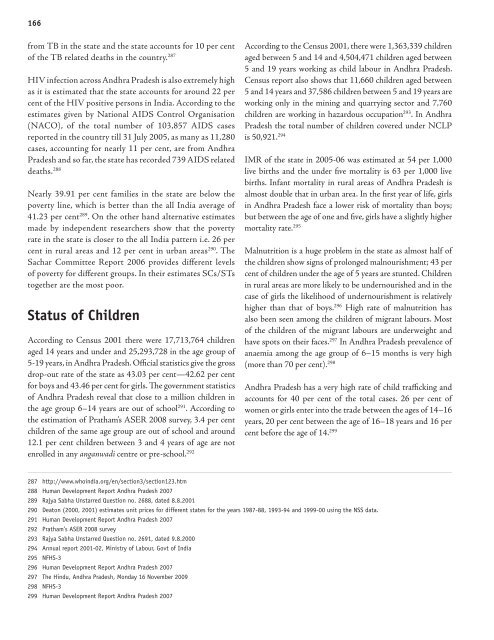Children - Terre des Hommes
Children - Terre des Hommes
Children - Terre des Hommes
Create successful ePaper yourself
Turn your PDF publications into a flip-book with our unique Google optimized e-Paper software.
166<br />
from TB in the state and the state accounts for 10 per cent<br />
of the TB related deaths in the country. 287<br />
HIV infection across Andhra Pra<strong>des</strong>h is also extremely high<br />
as it is estimated that the state accounts for around 22 per<br />
cent of the HIV positive persons in India. According to the<br />
estimates given by National AIDS Control Organisation<br />
(NACO), of the total number of 103,857 AIDS cases<br />
reported in the country till 31 July 2005, as many as 11,280<br />
cases, accounting for nearly 11 per cent, are from Andhra<br />
Pra<strong>des</strong>h and so far, the state has recorded 739 AIDS related<br />
deaths. 288<br />
Nearly 39.91 per cent families in the state are below the<br />
poverty line, which is better than the all India average of<br />
41.23 per cent 289 . On the other hand alternative estimates<br />
made by independent researchers show that the poverty<br />
rate in the state is closer to the all India pattern i.e. 26 per<br />
cent in rural areas and 12 per cent in urban areas 290 . The<br />
Sachar Committee Report 2006 provi<strong>des</strong> different levels<br />
of poverty for different groups. In their estimates SCs/STs<br />
together are the most poor.<br />
Status of <strong>Children</strong><br />
According to Census 2001 there were 17,713,764 children<br />
aged 14 years and under and 25,293,728 in the age group of<br />
5-19 years, in Andhra Pra<strong>des</strong>h. Official statistics give the gross<br />
drop-out rate of the state as 43.03 per cent—42.62 per cent<br />
for boys and 43.46 per cent for girls. The government statistics<br />
of Andhra Pra<strong>des</strong>h reveal that close to a million children in<br />
the age group 6–14 years are out of school 291 . According to<br />
the estimation of Pratham’s ASER 2008 survey, 3.4 per cent<br />
children of the same age group are out of school and around<br />
12.1 per cent children between 3 and 4 years of age are not<br />
enrolled in any anganwadi centre or pre-school. 292<br />
According to the Census 2001, there were 1,363,339 children<br />
aged between 5 and 14 and 4,504,471 children aged between<br />
5 and 19 years working as child labour in Andhra Pra<strong>des</strong>h.<br />
Census report also shows that 11,660 children aged between<br />
5 and 14 years and 37,586 children between 5 and 19 years are<br />
working only in the mining and quarrying sector and 7,760<br />
children are working in hazardous occupation 293 . In Andhra<br />
Pra<strong>des</strong>h the total number of children covered under NCLP<br />
is 50,921. 294<br />
IMR of the state in 2005-06 was estimated at 54 per 1,000<br />
live births and the under five mortality is 63 per 1,000 live<br />
births. Infant mortality in rural areas of Andhra Pra<strong>des</strong>h is<br />
almost double that in urban area. In the first year of life, girls<br />
in Andhra Pra<strong>des</strong>h face a lower risk of mortality than boys;<br />
but between the age of one and five, girls have a slightly higher<br />
mortality rate. 295<br />
Malnutrition is a huge problem in the state as almost half of<br />
the children show signs of prolonged malnourishment; 43 per<br />
cent of children under the age of 5 years are stunted. <strong>Children</strong><br />
in rural areas are more likely to be undernourished and in the<br />
case of girls the likelihood of undernourishment is relatively<br />
higher than that of boys. 296 High rate of malnutrition has<br />
also been seen among the children of migrant labours. Most<br />
of the children of the migrant labours are underweight and<br />
have spots on their faces. 297 In Andhra Pra<strong>des</strong>h prevalence of<br />
anaemia among the age group of 6–15 months is very high<br />
(more than 70 per cent). 298<br />
Andhra Pra<strong>des</strong>h has a very high rate of child trafficking and<br />
accounts for 40 per cent of the total cases. 26 per cent of<br />
women or girls enter into the trade between the ages of 14–16<br />
years, 20 per cent between the age of 16–18 years and 16 per<br />
cent before the age of 14. 299<br />
287 http://www.whoindia.org/en/section3/section123.htm<br />
288 Human Development Report Andhra Pra<strong>des</strong>h 2007<br />
289 Rajya Sabha Unstarred Question no. 2688, dated 8.8.2001<br />
290 Deaton (2000, 2001) estimates unit prices for different states for the years 1987-88, 1993-94 and 1999-00 using the NSS data.<br />
291 Human Development Report Andhra Pra<strong>des</strong>h 2007<br />
292 Pratham’s ASER 2008 survey<br />
293 Rajya Sabha Unstarred Question no. 2691, dated 9.8.2000<br />
294 Annual report 2001-02, Ministry of Labour, Govt of India<br />
295 NFHS-3<br />
296 Human Development Report Andhra Pra<strong>des</strong>h 2007<br />
297 The Hindu, Andhra Pra<strong>des</strong>h, Monday 16 November 2009<br />
298 NFHS-3<br />
299 Human Development Report Andhra Pra<strong>des</strong>h 2007






